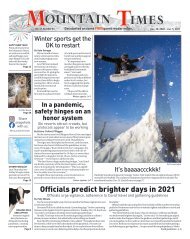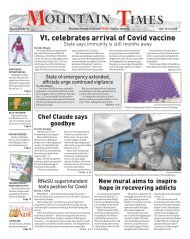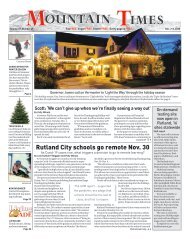Mountain Times: Volume 49, number 10: March 4-10, 2020
Create successful ePaper yourself
Turn your PDF publications into a flip-book with our unique Google optimized e-Paper software.
Columns<br />
40 • The <strong>Mountain</strong> <strong>Times</strong> • Mar. 4-<strong>10</strong>, <strong>2020</strong><br />
On a picture-perfect winter morning last year, 20 Saint<br />
Michael’s College students and I visited Vermont Fish and<br />
Wildlife scientists for ice fishing at Knight’s Point on Lake<br />
Life at 39 degrees<br />
Champlain. We drilled holes, baited hooks, learned about<br />
ice safety, identified fish – and<br />
even caught a few.<br />
The ice we tentatively walked<br />
on provides unshakably constant<br />
temperatures for those living<br />
in the water below. Burlington’s<br />
February 2019 air temperature<br />
ranged from 72 degrees to negative<br />
30, but water temperatures<br />
The Outside<br />
Story in Lake Champlain fluctuated a<br />
By Declan mere seven degrees, from 32 just<br />
beneath the ice to 39 degrees at<br />
McCabe<br />
depth. This aspect of the underice<br />
environment never changes; 39-degree water remains<br />
a winter constant unless lakes freeze solid or stop freezing<br />
altogether.<br />
Water is most dense at 39 degrees. When it cools below<br />
that temperature, it expands, which is why ice floats. In<br />
frozen lakes, the coldest water remains just beneath the<br />
ice, where on very cold days that water freezes, adding to<br />
the thickness of the ice. Meanwhile, the denser, 39-degree<br />
water sinks below this near-freezing layer and extends all<br />
the way to the lake floor. Fish, insects, amphibians, and a<br />
few brave mammals are exquisitely attuned to this winter<br />
reality.<br />
The creatures who survive under the ice have evolved<br />
over eons, fine-tuning their physiology and behavior to<br />
thrive at that specific 39-degree mark, which remains a<br />
winter constant from year to year and lake to lake. Just as<br />
our enzymes work best at a body temperature of 98.6 degrees,<br />
fish enzymes work best at fish body temperatures,<br />
which change with the season. As lake water cools, fish<br />
stop making enzymes that worked in summer temperatures<br />
and start producing winter versions.<br />
Different fish species take different measures to<br />
survive this chilly winter water. Some, like yellow perch<br />
and large-mouth bass, adjust by slowing their activities,<br />
metabolisms, and need for food. Others, like northern<br />
pike, remain more active. But even less lively fish can<br />
still be tempted by a tasty morsel; ice fishing in the North<br />
Country may yield yellow perch, salmon, trout, walleye,<br />
and rainbow smelt.<br />
Smelt have an unusual ace up their fishy sleeves for<br />
survival at low temperatures: antifreeze. As temperatures<br />
cool, smelt produce increasing quantities of glycerol.<br />
Combined with antifreeze proteins, glycerol keeps smelt<br />
moving, even at temperatures below 32 degrees. This trait<br />
is useful for smelt populations that migrate to sea, where<br />
the saltwater freezes at 28 degrees. It also explains why a<br />
baited hook dropped through a hole in lake ice can land<br />
smelt in even the coldest conditions. And for those lucky<br />
to catch enough smelt for a meal, the glycerol contributes<br />
to the sweet taste of this fish.<br />
Many of New England’s frogs also overwinter under<br />
ice. Contrary to popular belief, few frogs hibernate<br />
buried in mud. These amphibians absorb oxygen directly<br />
through their skin, an impossible feat in anoxic mud.<br />
Frogs are typically found on top of the lake or pond floor,<br />
and often near inflowing streams and seeps, where currents<br />
deliver oxygenated water. Although frogs in winter<br />
cease feeding and slow down to conserve energy, if stimulated<br />
they can still move and swim.<br />
Springtime melt brings a gradual transition from ice to<br />
open water at a rate that allows organisms to adjust. Once<br />
water warms from near freezing to 39 degrees, density<br />
differences disappear, resulting in a fleeting uniformly<br />
warm water column. Gradually, the surface water will<br />
warm even more, but there will still be plenty of cold places<br />
at depth. Life within the lake adjusts to the changes.<br />
As the water warms, frogs stretch their legs once more,<br />
surface for air, and return to full activity. Fish stop making<br />
cold-optimized enzymes and switch to summer equivalents,<br />
and they increase their foraging.<br />
Some fish, however, continue to seek cooler waters<br />
even in the heat of summer. Rainbow smelt eschew warm<br />
shallow water and migrate to deeper, cooler haunts. More<br />
than 90 percent of the 1,600 smelt University of Vermont<br />
researchers netted during a 2007-2008 study came from<br />
60 feet below the surface or deeper, where the water temperature<br />
was 45 degrees and cooler, even in mid-summer.<br />
And what of our winter ice fishing adventure? Twenty<br />
students fishing for two hours yielded three yellow perch,<br />
none of edible size and all dutifully returned from whence<br />
they came. It seems we are little threat to Lake Champlain<br />
fish stocks, and should be grateful for a well-stocked<br />
cafeteria.<br />
Declan McCabe teaches biology at Saint Michael’s<br />
College. His work with student researchers on insect communities<br />
is funded by Vermont EPSCoR’s Grant NSF EPS<br />
Award #1556770 from the National Science Foundation.<br />
The illustration for this column was drawn by Adelaide<br />
Tyrol. The Outside Story is assigned and edited by Northern<br />
Woodlands magazine and sponsored by the Wellborn Ecology<br />
Fund of New Hampshire Charitable Foundation.<br />
Investing: simple,<br />
yet difficult<br />
Warren Buffett said, “Investing is simple, but not<br />
easy.” Sounds like a contradiction, but in real life simplicity<br />
has little to do with ease. Take losing weight. Very<br />
simple. Burn more calories than<br />
you take in. Not so easy!<br />
The path to our long-term<br />
goals is often filled with conflicting<br />
short-term desires. As investors,<br />
we want to achieve good<br />
returns with minimal fluctuation.<br />
We want to maximize return<br />
Money<br />
Matters<br />
By Kevin Theissen<br />
in good times and prevent the<br />
chance of loss in the short term.<br />
This desire is heightened even<br />
more during periods of crisis and<br />
uncertainty.<br />
We have the best of intentions. We want to provide for<br />
our family and not have to worry about money so our<br />
efforts can be on those<br />
Uncertainty and<br />
discomfort are<br />
the price we<br />
pay to achieve<br />
greater longterm<br />
returns.<br />
things that matter most<br />
to us. But our emotions<br />
can get in the way.<br />
Sometimes we make<br />
financial decisions that<br />
satisfy our short-term<br />
emotional urges at a<br />
significant long-term<br />
cost.<br />
Markets can move<br />
quickly in both directions.<br />
Did you know that over the past 20 years six of the<br />
<strong>10</strong> best days occurred within two weeks of the <strong>10</strong> worst<br />
days? Just missing a few days in the market can be very<br />
costly.<br />
• S&P 500 returns from Jan 1999 – Dec 2018<br />
• Fully Invested Entire Time 5.6%<br />
• Missed <strong>10</strong> Best Days 2.0%<br />
• Missed 20 Best Days -0.3%<br />
• Missed 30 Best Days -2.3%<br />
There is a cost to feeling comfortable. Uncertainty<br />
and discomfort are the price we pay to achieve greater<br />
long-term returns. We may understand this, but it still<br />
doesn’t make it easy. We cannot predict the market, but<br />
we can counsel together to ensure your decisions are<br />
made with the correct perspective and in line with your<br />
long-term goals.<br />
Kevin Theissen is the owner of HWC Financial in<br />
Ludlow.<br />
Did you know that you<br />
could receive tax help?<br />
Some taxpayers may<br />
be eligible for free tax<br />
help through a program<br />
offered by the United<br />
States Internal Revenue<br />
Service. The Volunteer<br />
Income Tax Assistance<br />
(VITA) program offers<br />
free tax help to people<br />
who generally earn<br />
$56,000 or less, as well as<br />
persons with disabilities<br />
and people who are not<br />
fluent in English. People<br />
who are 60 years of age or<br />
older also are eligible for<br />
free tax help through the<br />
Tax Counseling for the<br />
Elderly (TCE) program,<br />
which specializes in<br />
questions about pensions<br />
and retirement-related<br />
issues. The availability of<br />
volunteers that work with<br />
these programs can vary<br />
based on the amount<br />
of certified individuals<br />
with tax law expertise in<br />
a given area. As a result,<br />
anyone hoping to<br />
take advantage of these<br />
services should consider<br />
contacting these programs<br />
well in advance of<br />
the deadline to file their<br />
returns. The deadline to<br />
file tax returns is Wednesday,<br />
April 15, <strong>2020</strong>.

















